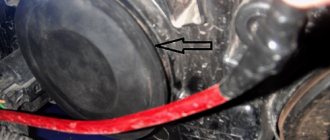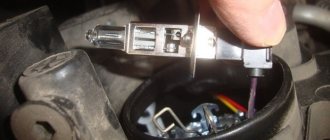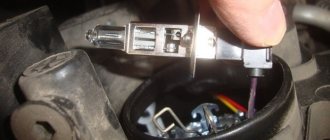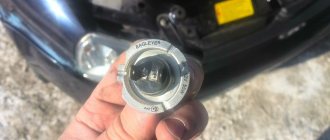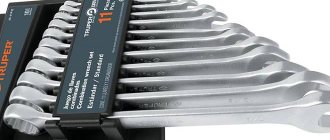If the low beam lamps on a car often burn out, it doesn’t matter whether one or all of them at the same time, then the first thing to do is measure the voltage in the on-board network.
This is not difficult to do - take a multimeter, set the measurement threshold to no more than 20 volts, start the car, connect the black wire of the device to the minus, and the red wire to the positive of the battery. The readings should not exceed 14.5V.
There is no point in taking readings directly on the lamp since they will still be less there (voltage loss on the connectors and in the wires).
If the voltage is higher than 14.5 volts, then the battery may be overcharged, keep this in mind.
What are lamps afraid of?
Any low or high beam lamps on a car will burn out prematurely if:
- Dirt got on them;
- You pawed them with your hands;
- You often drive on bad roads and the car constantly shakes;
- You close the hood with force, for example, throw it, and vibration is transmitted to the nearby lamps;
- Cold - at low temperatures, the resistance in the wiring decreases, which means the starting current increases, which is why the low beam lamp may burn out when starting the engine in severe frost (read the continuation of the topic below);
- Voltage drop and increased current.
What if the sensors feel strange or the needles are attached?
When sensors seem to move erratically or have the longest possible delay, the problem is usually a bad component, such as the device's voltage regulator or a bad ground.
Erratic gauges, or gauges that seem to read uniformly low, are usually caused by a bad tool voltage regulator. In some cases, you can remove the regulator, clean the connector terminals, and reinstall it.
Gauges that read completely all the time are usually caused by a weak or poor ground. If you can locate the ground, either visually or via an electrical diagram, you'll need to make sure it's secure and free of rust or corrosion.
Which lamps burn out more often?
There is no need to hope that expensive products from Philips burn out less often than from the Chinese “Mayak”; it happens, just the opposite.
Here the problem should be looked for not in the quality of the product or in the manufacturer, but in the operating features of the car’s electronics and its design. We should also not forget about a number of factors that affect the service life of lighting fixtures, but more about them below.
Low beam lamps located on the driver's left tend to burn out more often than those on the right.
This is due to the fact that the wires going from the switching unit to the headlights have different lengths, and, accordingly, different resistance (R).
From physics we know that the amount of current is inversely proportional to the amount of resistance.
That is, if a wire goes to the left headlight that is half as long as to the right one, and this is actually the case, then the starting current will flow to it twice as much, which reduces the service life of the device.
On most modern cars, the low beam headlights turn on automatically when the engine is started. At this time, the engine is just starting to pick up speed and does not work stably, the starter stops rotating and the generator starts working, and the battery begins to receive charging current.
All these switching modes negatively affect the operation of electronics, including lighting devices.
Therefore, if possible, and many cars have it, first start the engine, and after a while turn on the low beam headlights, or better yet, the running lights if they have them.
Also, in order to extend the “life” of the lamps, many craftsmen install special boards for smooth ignition of the low beam, solder in diodes, running light relays, but this is another story and a difficult solution for the average car enthusiast.
What to do when the sensors in your car don't work
The dashboard lights in your car tell a complex story about everything from your current speed, to the health and condition of your engine, and even whether things like your headlights are on. Different vehicles have different gauges, and some dashboards are much more complex than others. But when the sensors in your car stop working, you cannot ignore the situation.
When one sensor stops working, the problem may be the sensor itself or a bad sensor, while all the sensors going off at the same time often indicate a blown fuse or faulty instrument cluster.
The most common causes of sensor failure in a car can be broken down into three scenarios:
None of the sensors are working.
- If none of the sensors work at all, the problem may be a blown fuse or a faulty instrument cluster.
- If all the gauges are reading low or erratic, there may be a problem with the voltage regulator that powers the instrument cluster.
- If all the sensors are connected to the highest possible reading, it may be due to a wiring problem or a bad voltage regulator on the unit.
Interrelation of factors
The service life of all lamps, not just low beams, is influenced by a number of factors. We have already mentioned some of them above.
The table below shows the relationship between voltage, luminous efficiency and product life.
Here we see that 13.2V is taken as 100% - this is the voltage at which the ideal balance between service life and light output is achieved.
But then the following picture is observed - with an increase in voltage by 5% (to 13.86 volts), light transmission increases only by 18%, and the lamp service life drops by 40% (to 60). And with a reading of 14.15V, the light transmission will increase only by 2.5 - 3%, and the service life will decrease by another 18%, i.e. up to 42% of the declared one.
In other words, increased voltage, especially sudden surges, negatively affect the service life of products.
The low beam lamp in the left headlight constantly burns out, please give me some advice.
Hello everyone. I have a problem here, it’s been bothering me for a long time - when I turn on the low beam, the light in the left headlight goes out, plus the low beam lamp in the same headlight often burns out (in the last 2 months, 3 have burned out. 1st - 55W beacon, 2nd - OSRAM, 3rd - Philips, left from the previous owner, he apparently had the same problem). Today I drove into the garage, removed the chip from the headlight - when the light is off, absolutely all 5 contacts ring to ground. I turn on the dimensions - 12v appears on one of the wires, switch to the low one - these 12v disappear, appear on the other wire. There is no such thing on the right headlight. I pulled out the fuse - all 5 contacts in the chip still ring short with ground, and both contacts from the left headlight fuse also ring short with ground. The diagram in the manual is somehow flawed, and I’m not very good at car electrical, even now I can’t imagine where the short one might sit. can anyone tell me something?
Same bullshit. I blame the chatter (loss of contact). At this moment the light bulb burns out. The only problem is how to find it.
Until I changed it to xenon, I changed about 20 H7s. The manufacturer didn't matter. True, the right one always burned out first, and a little later the left. 1 month - 1 light bulb. I didn’t look for the reasons because it doesn’t bother me now.
There was such a problem, I changed a bunch of light bulbs until I bought Japanese HELLA ones and for 3 months without problems.
but I’m still inclined to think that I have a short one sitting somewhere, because in the connector that goes to the headlight, all 5 wires connect to the short one with ground, and I understand that there are 3 pluses: to the side, low beam and long-range, and 2 masses: one for long-range and the other for near-range with a clearance. on the other headlight, 2 wires ring short with ground - this seems to be the norm (I bought a car in August, and not a single lamp has burned out in this headlight). and one more thing that is incomprehensible, I was told today that on Japanese models the plus is permanently assembled, and the switches open/close the ground. Does anyone know if this is true or not? It’s a little cold here, and we don’t have our own garage, so I can’t check it. One good thing: in the morning at -34 I started it with the key :)
A dead battery in a multimeter is always sad. figured it out! This is all due to the crooked hands of the previous owner, who mixed up the wires when changing the headlights to European ones from 626.
on dorestayle, the ground wire for the low beam should be extended
Short ground wire. But they didn't teach physics at school. By lengthening the wire, the maximum we will achieve is an increase in the resistance of this wire, therefore heating this snot and this will not give anything good. As an auto electrician, I’ll say this is nonsense. Measure the voltage in the network, and separately on the light bulb
Last edited by demon626; 02/24/2013 at 15:27.
I'm glad to see a specialist appear on the forum.
Chevrolet Lacetti
In the Chevrolet Lacetti, the dimensions and low beam lamps are located next to each other, so they heat each other up greatly. This design decision negatively affected the service life of the latter, and they often burn out.
A solution to the problem can be found in replacing the dimensions with diode analogues, which heat up less, or installing a special relay that would turn off the side lights when the low beams are on. If you have your own solution to the problem, write in the comments.
What to do if only one sensor is not working?
When one sensor stops working, the problem is with the sensor, wiring, or sending device. If you are comfortable finding and removing sending devices and sensors, you can diagnose this type of problem yourself. Otherwise, you will have to take it to a mechanic.
Using the coolant temperature sensor as an example, the diagnostic procedure involves locating and disabling the sending unit. When the ignition is on, the sensor should register as cold. If you connect the sender wire to ground, the sensor should switch to a "hot" reading.
If the sensor moves as expected, you may suspect a bad sending unit. If the sensor does not move when you ground the sensor wire, you may suspect a bad sensor. Similar tests can be performed on all sensors in your instrument cluster, although specific procedures may differ from one application to another.
Niva Chevrolet
Niva Chevrolet has factory Philips LongLife low beam lamps, if they are burnt out, then try to install the same ones, as a rule, they last a long time, according to reviews 60,000 mileage, but no less than six months for sure.
The reasons for their burnout are the same (see above).
Many Niva Chevrolet car owners install xenon 5000 kelvin instead of burnt-out low beam lamps (lower is not reasonable), but it is important to install them correctly so as not to blind oncoming drivers. It is important to pay attention to the condition of the ignition units.
As a last resort, it is better to install inexpensive Chinese analogues of the “Mayak” type, which is not so expensive if they are replaced frequently.
Is it possible to save money?
If you were unable to get away with a simple warning for not working low beams or other lighting devices, you have the opportunity to pay a fine that is half the amount required.
According to Art. 32.2 of the Code of Administrative Offenses, all of the above articles fall under the opportunity to save 50% if you manage to pay the fine within a twenty-day period from the date of the decision on an administrative offense.
Kalina
The problem of low beam lamps burning out also affected the Lada Kalina. For some time, German products from OSRAM were installed on the car, which served for a very long time and the drivers were happy about it. Over time, the situation changed, and the problem worsened.
In addition to the general reasons mentioned above, this car model also has other reasons:
- The generator relay is faulty - as a rule, it changes. You need to contact a specialist;
- There have been cases when, in severe frost, a car's generator briefly produced a voltage of more than 15 volts. This led to the low beam lamps burning out if they were turned on immediately after starting the engine. To prevent this from happening, the low beam must be turned on only after preliminary operation of a strong current consumer (interior heater, etc.). Those. started the car, turned on the heater, let it run at maximum for 30-60 seconds, and then turned on the low beam headlights.
If you have your own experience in solving this problem on Lada Kalina, write in the comments.
What if the dashboard warning lights don't work?
While many vehicles have gauges that show specific information about everything from charging system status to coolant temperature, some cars and trucks have warning lights.
These warning lights are designed to illuminate when the input from a transmitting device or sensor is outside the expected range. So instead of a needle telling you that the coolant temperature is 230 degrees Fahrenheit, a similar red warning light will flash in the red danger zone, letting you know that the coolant is hotter than it should be.
These and other lights, such as your check engine light and ABS light, are designed to turn on when you turn the ignition key to the on position, which is called the check light bulb. If one or more light sources do not light up, it usually means the bulbs are burnt out.
If none of your dashboard warning lights turn on, including the check engine light, it is usually a fuse or a ground issue. This type of problem is diagnosed in the same way as a sensor that isn't working, so you'll have to check for power at the appropriate fuse and make sure the instrument cluster ground is good. If these things check, then the problem is usually a bad sending device or wiring.
Renault Logan
Renault Logan cars of the first assembly were previously equipped with OSRAM H4 Ultra Life 60/55w low beam lamps, about which you can only hear positive reviews from car owners.
Owners of the latest assemblies complain that low beam lamps often burn out.
The main reasons are the same as mentioned above (voltage surges, problems with the relay generator, etc.).
But Renault Logan is characterized by another problem - oxidized or carbonated contacts in the block to which the light sources are connected. For this reason, in these places the resistance increases, and therefore the ambient temperature, which is why the lamps burn out.
Many owners of this model praise products with thick thread from NARVA, but this is not a panacea.
What kind of lamps do you install in Renault Logan headlights and how did you solve the problems with their frequent burnout? Write in the comments.
What should I do if the indicator and instrument panel do not work?
If your gauges are not working and your instrument panels and indicators are also not illuminated, this is a sign that there may be a problem with the ground. This assumes that you have already checked the sensor fuse and determined that it is in good working order.
If the instrument cluster is not properly grounded, you will typically find that the indicators and instrument lamp do not work or only work intermittently. You may be able to test the ground by looking under the dash with a flashlight, but in many cases you will have to actually remove the instrument cluster.
Ford Focus 2
The car has products with an H7 socket. The manufacturer can be either General Electric or Philips. The first has the article 17123, the second has 12972 PR.
Common causes of optics burnout for Ford Focus 2 in addition to those listed above:
- Problems with the generator relay;
- The absence of a back cover in the headlight will lead to increased humidity, oxidation of the terminals, increased resistance in the circuit, and, accordingly, the air temperature in the area of the lamps.
- Incomplete fastening of the headlight to the body means there is a play that should not exist;
- The rubber plugs in the headlights are damaged or missing;
- Bad contacts in the fuse box responsible for daylight.
Some owners of Ford Focus 2, who were tired of constantly changing low beam lamps, approached the problem creatively - they installed a daylight control controller.
Thanks to this, only the high beam lamps work in the incandescent mode (drivers do not use them often). They are used instead of running lights.
This solution has a number of advantages:
- The side lights do not light up;
- The resource of low beam lamps is saved.
It is also worth paying attention to the correct installation of optics on the Ford Focus 2. First, the lamp is installed in the headlight and only then the base is connected. This prevents hand contact with the glass bulb.
If you have your own experience in this matter, write in the comments.
How to choose the right LEDs for a car
Miser pays twice. This saying has a lot to do with trying to save money on LEDs. A high-quality LED lamp is never cheap: an LED will either be inexpensive or will work for a long time - but not at the same time!
If the manufacturer is unknown, either refuse to purchase such an LED, or study the lamp itself:
- there should be no traces of casting or stamping on plastic elements;
- there should be no play or visible gaps on the base;
- the lamp should not flicker during operation;
- In terms of brightness, the lamp should not differ much from analogues with the same voltage consumption, power and temperature of the light flux.
The current and voltage characteristics must exactly correspond to the markings. When installing multiple LEDs into one driver, consider the overall current consumption level.
Lada Priora
Lada Priora was also affected by this problem. The reasons are still the same, but there is something to add here:
- Poor contact in the cartridge - clean it;
- Increased charge voltage - take measurements (see at the beginning of the article).
- Poor quality of products - use original ones.
Solution:
- Installation of DRLs (daytime running lights);
- Many Lada Priora owners praise the OSRAM SilverStar 2.0, Osram 64210 ALL, Philips 12972 PRC1 or factory Mayak LBS, but there are so many people and so many opinions.
Why do LED light bulbs burn out? Often in car headlights. I tell it on my fingers
It seems like progress, it seems like LED bulbs have appeared, and it seems that the problem with the dimensions - fog lights, and headlights - has almost been solved! BUT in practice everything turns out completely differently. LED side lights (purchased from Chinese counterparts) through websites or through our “resellers” burn out even faster than incandescent light bulbs, especially often in side lights. But why? What is it and where is the vaunted resource of several years. Today I will tell you in detail the essence of the process, there will also be a useful video version at the end of the article. So read and watch...
LED light bulbs don’t always just burn out; sometimes they wink (ala strobe). And here comes this car and it’s all blinking like a Christmas tree, IT JUST LOOKS TERRIBLE. If you wander around the forums, this kind of “prank” happens all the time, and some “especially lucky” people have to throw out their light bulbs after just a couple of days. To understand the whole process of failure, I offer you a little theory.
What are LEDs afraid of most?
Now I won’t go into the weeds and tell you what this light source consists of (that’s not what you came here for). You just need to understand why it “dies”, and quickly:
- This is the temperature . Diode crystals are strictly designed for the required temperature conditions. If it is exceeded, the crystal degrades very quickly, its service life is reduced by several times, if not tens of times. If you exaggerate, it will shine brightly, but not for long. That is why now many lamps have aluminum or even “cooler” cooling systems, which simply keep the temperature within the required limits, extending the life of the lamp MUCH. As some manufacturers assure, the normal temperature range is between + 35 and +40 degrees.
- Strictly defined current. LEDs are powered by a strictly defined current, which is specified by the manufacturer; it is possible to supply less, but it is not possible to supply more. Otherwise, very rapid degradation (again, strong heating) and failure. That is why in the structure of LED lamps there is a certain element that limits and stabilizes (does not give jumps) to the manufacturer’s limits that he has laid down.
- Strictly defined voltage. The ideal is considered to be 12.0V, which is almost ideal when the car is stationary and not running, but even then there is 12.5-12.7V unless, of course, your battery is almost completely discharged. But after starting, the generator starts working, producing 14.2 - 15V, and this is almost 20% more than the LED needs for a minute.
If you strictly follow these rules, then such lamps will work for a very, very long time. Really 20 - 25,000 hours (if the electronics don’t burn out faster).
About power stabilizing elements
Actually, there are also two large camps here, and this is VERY important to note:
- Dear lamps . Usually installed in the head light, they come with a built-in stabilizer, popularly called a “driver” (where I even read, they call it an “ignition unit,” although this is not correct). Everything here is more or less good, and now serious players are entering the market, such as PHILIPS, OSRAM and others who give fairly good guarantees for the lamps, that is, they WILL burn for a LONG time. But here, again, there is underground China, but with it everything is not so stable, they can install a small radiator, the lamp will still overheat, the coolers stand up, the stabilizers are made of who knows what, you take it like a “pig in a poke.” BUT they can still burn for a LONG time (we are getting closer to our cherished dream).
- Cheap and small lamps . These are installed in the dimensions, in the lighting of the license plate, interior, “dashboard”, etc. Here, as you understand, there simply cannot be such stabilizers, because the housing will not fit into the base or mounting location. They contain an ordinary resistor (for 3 kopecks), this is not a stabilizer, but simply a current limiter.
That is, to summarize, stabilizers (aka drivers) and ordinary resistors.
Why do the LEDs in the dimensions light up?
We will talk specifically about W5W lamps. Actually, everything can already be understood from the information above. However, it is worth drawing a line.
Of course, it is not true that there are no normal LED lamps for the dimensions, in fact there are, but they are from famous companies such as PHILIPS, OSRAM and others, they cost exorbitantly, can often reach up to 1000-1500 rubles. But their electronics are fine; they can limit both current and voltage. There is practically no heating and they work for a LONG time.
TO SAVE, many people buy lamps on Chinese sites like Aliexpress, Girbest and others. They buy it for three kopecks (about 10 rubles apiece), but here no one “bothers” with calculating the electronics inside. Therefore, when the voltage is exceeded (up to 14.2-15V), current consumption increases significantly, which leads to strong heating of the light bulb. Here you have the triple killer effect: excess voltage - excess current - strong heating, THIS LED lamp did not have long to LIVE. It’s safe to say that it will last a couple of months at most, then it will start blinking, and then it will simply refuse to work.
My experiment
What I decided to do was to show the dependence of voltage, consumption and heating of the lamp. I have a regular large LED lamp W5W, it has 8 small modules and one large one under glass (lens type).
If you connect it to a 12V power supply, then it consumes only 80 mA (or 0.96 Watt) and the heating of the lamp is stable, that is, when turned on, the temperature is approximately 31 degrees Celsius, and after 10 minutes of operation it is approximately 34 degrees.
Now let's take and simulate a voltage of 15V, what do we see - the consumption has grown right up to 150mA and continued to grow with the heating of the lamp 160-170mA (2.4-2.55 Watts), when turned on the temperature was 34 degrees Celsius, but after 10 minutes it reached 58 degrees. I think in half an hour it would be about +70! But there is also a “halogen” nearby, it also gives the temperature, so here you have critical heating, it won’t last long - it will soon burn out.
Here's a simple simulation of a running engine on a modern car; now some generators produce from 14.2 to 15V (albeit for a short time)!
Great Wall Hover H5
If the model has a gasoline engine, then when reverse gear is engaged, voltage surges occur. This is not the case in cars with diesel engines.
This is easy to diagnose - put the car in reverse and see how much the headlights have dimmed. If it is strong, then there is a danger of lamps burning out.
The problem is solved by installing a special stabilizer, it consists of:
- Diode;
- Relay;
- fuse;
- Capacitor 5000 uF 25V.
But for many this will be problematic. If you have your own solution to the problem, write in the comments.
When the speedometer doesn't work
While all gauges can be either analog or digital, speedometers are unique in that they can have mechanical or electrical inputs. All other instrument panels are connected to sensors or sending devices via wires, while your speedometer may use either a speed sensor or a physical cable.
In vehicles that use cables, the speedometer is physically connected to the transmission through the cable. The cable is usually square at both ends or square at one end and slotted at the other. When the cable breaks, the sensor may not move at all, or it may jerk a little.


